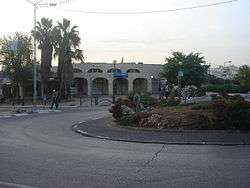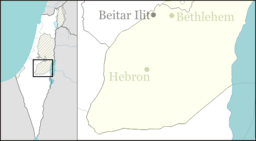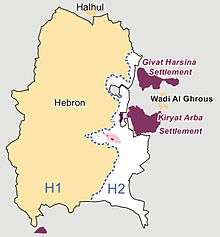Kiryat Arba
Kiryat Arba
| |
|---|---|
| Hebrew transcription(s) | |
| • ISO 259 | Qiryat ʔarbaˁ |
| • Also spelled | Qiryat Arba (official) |
 | |
 Kiryat Arba | |
| Coordinates: 31°31′42″N 35°7′7″E / 31.52833°N 35.11861°ECoordinates: 31°31′42″N 35°7′7″E / 31.52833°N 35.11861°E | |
| Region | West Bank |
| District | Judea and Samaria Area |
| Founded | 1968–1971 |
| Government | |
| • Type | Local council |
| • Head of Municipality | Malachi Levinger |
| Area | |
| • Total | 4,386 dunams (4.386 km2 or 1.693 sq mi) |
| Population (2017)[1] | |
| • Total | 7,339 |
| • Density | 1,700/km2 (4,300/sq mi) |
| Name meaning | Town of the Four [Giants] |
| Website | Official website |
Kiryat Arba or Qiryat Arba (Hebrew: קִרְיַת־אַרְבַּע), lit. "Town of the Four," is an urban Israeli settlement on the outskirts of Hebron, in the Judean Mountains region of the West Bank. Founded in 1968, in 2017 it had a population of 7,339.
The international community considers Israeli settlements illegal under international law, but the Israeli government disputes this.[2] According to a classified 1970 document “The method for establishing Kiryat Arba" released in 2016, the establishment of Kiryat Arba used a system of annexing land to a military base for the purpose of civilian settlement,[3] the first time this happened in the West Bank according to Shlomo Gazit.[3]
Etymology
Kiryat Arba is mentioned in the Hebrew Bible (Genesis 23) as the place where Abraham buried Sarah. The Book of Joshua chapter 14 verse 15 says (Darby Bible): "Now the name of Hebron before was Kirjath-Arba; the great man among the Anakim..."[4] There are various explanations for the name, not mutually exclusive. According to the Biblical commentator Rashi, Kiryat Arba ("Town of Arba") means either the town (kirya) of Arba, the giant who had three sons, or the town of the four giants: Anak (the son of Arba) and his three sons – Ahiman, Sheshai and Talmai – who are described as being the sons of a "giant" in Numbers 13:22: "On the way through the Negev, they (Joshua and Caleb) came to Hebron where [they saw] Ahiman, Sheshai and Talmi, descendants of the Giant (ha-anak)..."[5] Some say that Anak ("Giant", see Anak) is a proper name (Targum Jonathan and the Septuagint),[6] and that he, Anak, may have been the father of the three others mentioned in the Book of Numbers as living in Hebron, previously known as "Kiryat Arba."
Alternatively, the name may refer to the four couples buried in the Machpela Cave: Abraham and Sarah, Isaac and Rebecca, Jacob and Leah, and according to the Zohar, Adam and Eve.[7]
History

A secret government plan to establish the settlement began with the expropriation of Palestinian land ostensibly for a military base.[8] According to the minutes of a meeting between senior officials in the office of Defense Minister Moshe Dayan in July 1970, houses would be constructed "for military purposes" before being turned over to Jewish civilians as a settlement.[8] This method of settlement foundation, which was very common at the time, was intended to give the appearance of compliance with International Law.[8] Israeli settlers claimed that Jewish settlement around Hebron was justified in light of the 1929 Hebron massacre and the continuous presence of Jews in the area until then.[9] The town is a self-sufficient community, with pre-nursery through post-secondary educational institutions, medical facilities, shopping centers, a bank and a post office. Kiryat Arba attained local council status in 1979. While Kiryat Arba is located within the territory of the Har Hebron Regional Council, it is an independent local council.[10][11]
Israeli settlers living at Kiryat Arba have been subjected to multiple attacks by Palestinians. In 1980, three 20-year-old yeshiva students studying in Kiryat Arba were among the six Jews killed by terrorists after praying in the Cave of the Patriarchs in Hebron on Friday night.[12] Between 1981 and 1986, four people from Kiryat Arba were shot and wounded in the Hebron marketplace. In 1994, a 17-year Sarit Prigral from Kiryat Arba was shot and killed in a drive-by shooting.[13][14] In March 2003, Eli and Dina Horowitz were shot to death in their home and five others wounded.[15][16][15] On November 26, 2009, a Palestinian stabbed and wounded two Israelis at a Kiryat Arba gas station. The Palestinian was then shot dead by an Israeli soldier.[17] On August 31, 2010, four residents, including a pregnant woman, were shot to death in their car by Hamas militants outside Kiryat Arba.[18] The Palestinian Authority arrested the perpetrators, but promptly released them after Hamas accused it of treason. On October 8, 2010, Israeli troops killed two of the perpetrators and arrested six during a raid in Hebron. In October 2011, a Palestinian stoning attack near Kiryat Arba caused the car of a resident to overturn, killing him and his infant son. The man's handgun and wallet were then stolen.[19] Following an investigation by Shin Bet, the IDF and police, two Palestinians from Halhul were arrested for throwing the stones that caused the car to overturn, and three others were arrested for stealing the gun.[20] On June 30, 2016, a Palestinian from the nearby village of Bani Naim entered a house in Kiryat Arba and stabbed to death 13-year-old Hallel Yaffa Ariel, an Israeli-American girl. The attacker was shot to death, after also wounding a security guard who responded to the Ariel stabbing.[21]
Baruch Goldstein, a Kiryat Arba physician, was responsible for the Cave of the Patriarchs massacre during which 29 unarmed Palestinian worshippers were shot to death and 125 others were wounded.[13]
Status under international law

Like all Israeli settlements in the Israeli-occupied territories, Kiryat Arba is considered illegal under international law, though the Israeli government disputes this.[2][22] The international community considers Israeli settlements to violate the Fourth Geneva Convention's prohibition on the transfer of an occupying power's civilian population into occupied territory.[23] Israel disputes that the Fourth Geneva Convention applies to the Palestinian territories as they had not been legally held by a sovereign prior to Israel taking control of them. This view has been rejected by the International Court of Justice and the International Committee of the Red Cross.[24]
Landmarks
Kahane Park is named for Rabbi Meir Kahane, founder of Kach, a far right political party that is banned and considered a terrorist organization in Israel. Meir Kahane was assassinated in the United States by an Arab gunman.[25] The grave of Baruch Goldstein, who perpetrated the Cave of the Patriarchs massacre, is across the street from the park.
Notable residents
- Sarah Avraham, Indian-born Israeli kickboxer, 2014 Women's World Thai-Boxing Champion at 57-63 kilos (125–140 pounds)
- Dov Lior, chief rabbi and rosh yeshiva
- Rabbi Moshe Levinger, Israeli Religious Zionist and an Orthodox Rabbi
- Baruch Goldstein, perpetrator of the Cave of the Patriarchs Massacre
- Elyakim Ha'etzni, former lawyer and Knesset member
References
- ↑ "List of localities, in Alphabetical order" (PDF). Israel Central Bureau of Statistics. Retrieved August 26, 2018.
- 1 2 "The Geneva Convention". BBC. December 10, 2009.
- 1 2 Secret 1970 Document Confirms First West Bank Settlements Built on a Lie
- ↑ "Joshua 14 / Hebrew – English Bible". Mechon-Mamre. Retrieved April 10, 2014.
- ↑ "Navigating the Bible". Bible.ort. Retrieved April 10, 2014.
- ↑ "Navigating the Bible: Giant". Bible.ort. Retrieved April 10, 2014.
- ↑ Winter, Dave (1999). Israel Handbook.
- 1 2 3 Yotam Berger (July 28, 2016). "Secret 1970 Document Confirms First West Bank Settlements Built on a Lie". Haaretz.
- ↑ Michael Feige (2009). Settling in the Hearts: Jewish Fundamentalism in the Occupied Territories. Wayne State University Press. p. 152. ISBN 978-0814327500.
- ↑ "Beit HaShalom – the House of Peace – a new Jewish building in Hebron". March 19, 2007. Archived from the original on April 30, 2007.
- ↑ Jpost Archived January 11, 2012, at the Wayback Machine.
- ↑ "Palestinian terrorist in killing of 6 Jews elected Hebron mayor". Times of Israel. 14 May 2017. Retrieved 19 August 2018.
- 1 2 "Terrorist attacks and violent incidents in Kiryat Arba". Jewishvirtuallibrary.org. Retrieved April 10, 2014.
- ↑ "Comprehensive Listing of Terrorism Victims in Israel". www.jewishvirtuallibrary.org. Retrieved 2017-10-24.
- 1 2 "Victims of Palestinian Violence and Terrorism Since 2000". Israel Ministry of Foreign Affairs.
- ↑ "Dina Horowitz". Israel Ministry of Foreign Affairs. Retrieved 2017-10-24.
- ↑ Fendel, Hillel (November 26, 2009). "Kiryat Arba: Two Wounded in Terror Stabbing". Arutz Sheva.
- ↑ Kieron Monks (November 2, 2010). "The Lawless West Bank: The Next Powder Keg?". Newstatesman.com. Retrieved April 10, 2014.
- ↑ Altman, Yair (September 25, 2011). "Police conclude Kiryat Arba car crash a terror attack". YNet.
- ↑ Altman, Yair (October 6, 2011). "2 Palestinians arrested for Palmer murder".
- ↑ "Israeli girl stabbed to death by Palestinian inside bedroom". BBC News. BBC. 30 June 2016. Retrieved 30 June 2016.
- ↑ Israel settlers obstruct building curbs inspectors BBC News. December 1, 2009
- ↑ The settlers' struggle BBC News. December 19, 2003
- ↑ Legal Consequences of the Construction of a Wall in the Occupied Palestinian Territory Archived July 6, 2010, at the Wayback Machine. International Court of Justice, July 9, 2004. pp. 44–45
- ↑ Specter, Michael (November 6, 1990). "Jewish Leader Kahane Slain in New York". Washington Post.